Provincial Disaster Management Authority (PDMA)
The Provincial Disaster Management Authority (PDMA) Punjab functions as a key governmental body tasked with handling disaster-related affairs within the Punjab province of Pakistan. Operating under the oversight of the National Disaster Management Authority (NDMA), the PDMA is responsible for ensuring provincial-level readiness and coordination during emergencies.
Its core mission involves boosting the province’s capacity to prepare for, respond to, and recover from various crises. These may include natural hazards such as floods, earthquakes, droughts, and disease outbreaks, as well as human-caused emergencies, including industrial mishaps and acts of terrorism.

Related Legislation
- National Disaster Management Act, 2010
References
- PDMA Punjab Core Team
- “PDMA develops app to address smog complaints”, 28 March 2023
- PDMA Punjab Profile on Devex
- Flood Warning Issued by PDMA Punjab
Disaster & Emergency Management Structure in Pakistan
Federal Agencies:
- National Disaster Management Authority (NDMA)
- Directorate General of Civil Defence
- Federal Flood Commission
- Rescue 1122
Regional Authorities:
- Punjab: PDMA Punjab, Civil Defence Department, Punjab Emergency Service
- Sindh: PDMA Sindh, Civil Defence Department, Sindh Emergency Rescue Service
- Khyber Pakhtunkhwa: PDMA KPK, Civil Defence Department, KP Emergency Rescue Service
- Balochistan: PDMA Balochistan, Civil Defence Department, MERC-1122
- Gilgit-Baltistan: GB Disaster Management Authority, Civil Defence, Emergency Service
- Azad Jammu and Kashmir: AJK State Disaster Management Authority, Civil Defence, AJK Emergency Service
Voluntary Organizations:
- PRCS, PBS, APGG, GGA
Operational Centers:
- Active: National Emergency Operations Center (NEOC)
- Inactive: National Flood Response & Coordination Centre (NFRCC)
See Also:
- Emergency Management in Pakistan
- National Disaster Management Act, 2010
Emergency Management in Pakistan
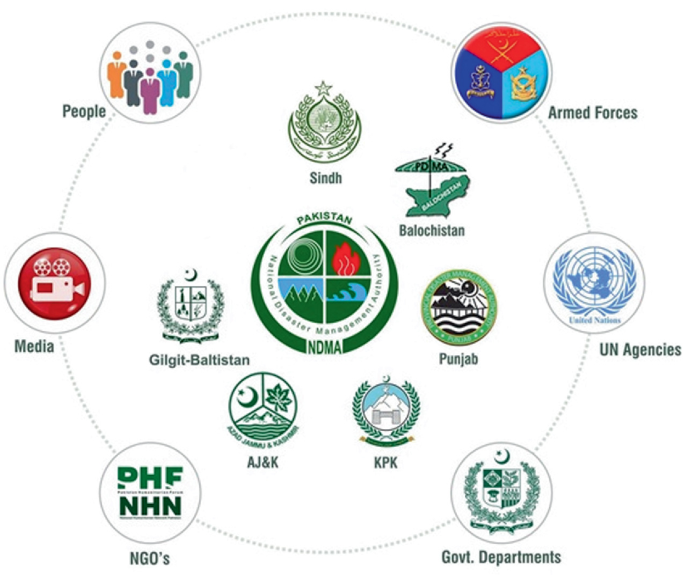
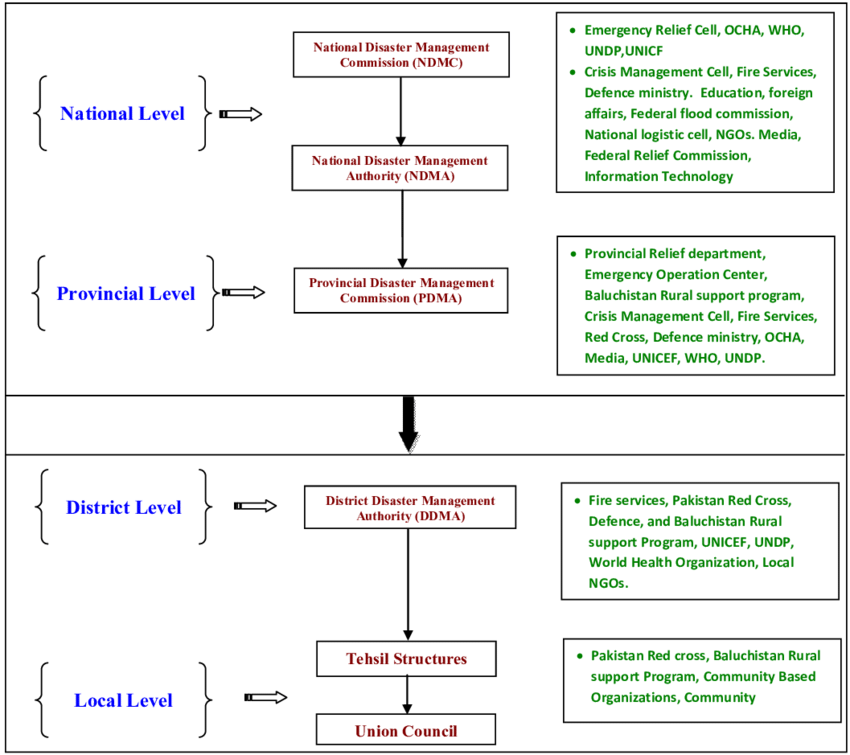
Emergency management in Pakistan involves a coordinated system of organizations, laws, and strategies aimed at reducing the impact of disasters and ensuring rapid response and recovery during emergencies. It covers natural calamities like earthquakes and floods, as well as man-made crises such as industrial accidents, armed conflict, and terrorist activities.
National Framework
At the federal level, the National Disaster Management Authority (NDMA) leads the country’s efforts in planning, policy-making, and coordination for disaster risk reduction and emergency preparedness. It was established under the National Disaster Management Act, 2010, which provides a legal and institutional framework for disaster risk management across Pakistan.
NDMA works in collaboration with:
- Directorate General of Civil Defence
- Federal Flood Commission
- Rescue 1122 (National Level)
- National Emergency Operations Center (NEOC)
The NDMA formulates national plans and guidelines, provides training, and mobilizes resources during major disasters.
Provincial and Regional Bodies
Each province and region in Pakistan has its own disaster management authority operating under the NDMA’s umbrella. These include:
- PDMA Punjab
- PDMA Sindh
- PDMA Khyber Pakhtunkhwa (KPK)
- PDMA Balochistan
- Gilgit-Baltistan Disaster Management Authority
- State Disaster Management Authority (Azad Jammu & Kashmir)
These regional agencies are responsible for local-level planning, early warning systems, rescue operations, relief distribution, and community awareness campaigns.
Emergency Services and Civil Defence
Complementing the disaster management authorities are dedicated emergency services such as:
- Punjab Emergency Service (Rescue 1122)
- Sindh Emergency Rescue Service
- KPK Emergency Rescue Service
- Balochistan MERC-1122
- Civil Defence Departments in all provinces
These organizations are trained to handle urgent situations ranging from road accidents to large-scale disasters.
Voluntary and Support Organizations
Numerous volunteer-based and humanitarian organizations play a significant role in emergency preparedness and response, including:
- Pakistan Red Crescent Society (PRCS)
- Pakistan Boy Scouts Association
- Pakistan Girl Guides Association
- National and international NGOs
These groups often assist in relief efforts, shelter provision, and community resilience building.
Challenges in Emergency Management
Despite a structured system, Pakistan faces several challenges in managing emergencies effectively:
- Inadequate infrastructure and early warning systems in rural areas
- Limited public awareness about disaster preparedness
- Urban planning issues that exacerbate flood and fire risks
- Climate change is increasing the frequency and severity of natural disasters
Recent Developments
Pakistan continues to improve its emergency response capabilities through:
- Technological integration (e.g., mobile apps for disaster alerts and complaint systems)
- Public-private partnerships
- Community-based disaster risk reduction programs
- International collaboration for training and equipment support
National Disaster Management Act, 2010
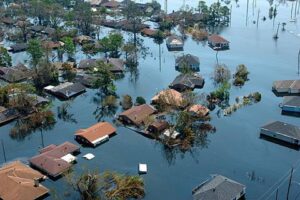
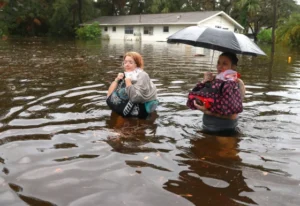
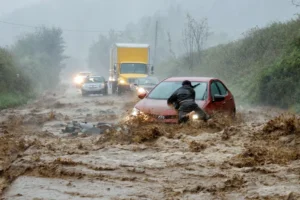
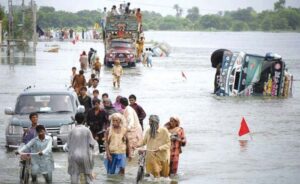
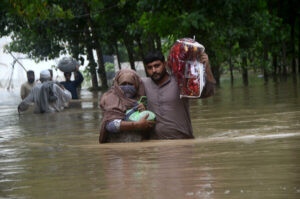
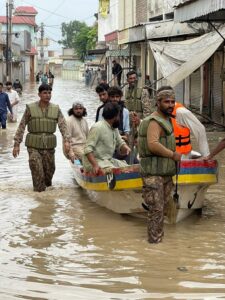
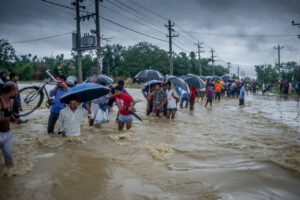
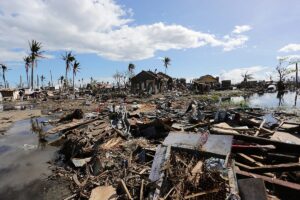
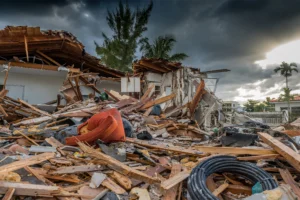
The National Disaster Management Act, 2010, is the cornerstone legislation in Pakistan that establishes a comprehensive legal and institutional framework for disaster risk management across the country. Enacted by the Parliament, the Act defines roles, responsibilities, and coordination mechanisms for dealing with natural and man-made disasters.
Purpose and Objectives
The Act was introduced to:
- Develop a structured approach for disaster preparedness, mitigation, and response.
- Establish national and provincial bodies for managing disasters.
- Promote risk reduction strategies and enhance community resilience.
- Ensure coordination between federal, provincial, and local authorities during emergencies.
Key Features
1. Institutional Structure
The Act provides for the creation of the following bodies:
- National Disaster Management Commission (NDMC):
Headed by the Prime Minister, this is the apex policy-making body responsible for formulating national disaster policies and overseeing their implementation. - National Disaster Management Authority (NDMA):
The federal agency is responsible for executing and coordinating disaster response and preparedness strategies at the national level. - Provincial Disaster Management Commissions (PDMCs):
These commissions operate under the leadership of provincial chief ministers and set disaster management policies at the provincial level. - Provincial Disaster Management Authorities (PDMAs):
Tasked with executing the disaster management plans and ensuring preparedness and response mechanisms within the provinces. - District Disaster Management Authorities (DDMAs):
Function at the district level to implement local disaster response plans and coordinate relief efforts.
2. National and Local Plans
The Act mandates:
- Formulation of National Disaster Management Plans by NDMA.
- Development of provincial and district-level disaster plans.
- Integration of disaster risk reduction into development planning and governance.
3. Powers and Functions
The Act empowers disaster management authorities to:
- Coordinate rescue, relief, and rehabilitation activities.
- Conduct risk assessments and vulnerability mapping.
- Develop early warning systems and evacuation strategies.
- Mobilize financial and technical resources during crises.
- Engage in awareness and training programs for disaster preparedness.
Legal Enforcement
Authorities established under the Act can:
- Issue directives to any government agency or department to carry out specific disaster-related tasks.
- Ensure compliance with safety codes, building regulations, and land-use planning to minimize disaster impact.
Impact and Relevance
Since its passage, the Act has helped standardize disaster management practices across Pakistan. It provided a legal basis for the establishment of NDMA and PDMAs and shaped the country’s response to major disasters such as:
- The 2010 floods
- The 2005 earthquake
- The COVID-19 pandemic
The Act also aligns Pakistan with international frameworks like the Sendai Framework for Disaster Risk Reduction.
Challenges
Despite its strengths, implementation challenges remain:
- Resource constraints at the district and provincial levels
- Lack of public awareness and preparedness
- Inadequate coordination among institutions in some cases
- Need for frequent updates to disaster plans based on evolving climate and security risks
Solutions to Stop or Reduce Floods
1. Improved Drainage Systems
- Upgrade urban drainage networks to prevent waterlogging.
- Regular maintenance of storm drains to removing blockages and debris.
- Install permeable pavements to allow rainwater to seep into the ground.
2. Construction of Flood Barriers
- Build levees, embankments, and floodwalls along rivers and vulnerable areas.
- Use temporary barriers or inflatable dams in emergencies.
3. Reforestation and Watershed Management
- Plant trees and restore forests in upstream catchment areas to reduce runoff.
- Preserve wetlands and floodplains to act as natural water absorbers.
4. Rainwater Harvesting
- Encourage rooftop rainwater harvesting to reduce surface runoff.
- Install underground storage tanks to collect excess rainwater.
5. Dams and Reservoirs
- Construct and maintain multipurpose dams to store floodwater.
- Regulate river flow through controlled releases during heavy rainfall.
6. Zoning and Land Use Planning
- Implement floodplain zoning laws to prevent construction in high-risk areas.
- Develop flood-resilient infrastructure using elevated structures and water-resistant materials.
7. Early Warning Systems
- Deploy real-time flood forecasting systems using sensors and satellite data.
- Issue timely alerts and evacuation warnings to communities through mobile apps, SMS, and sirens.
8. Community Awareness and Training
- Conduct flood preparedness drills in schools and neighborhoods.
- Educate the public on emergency response plans and evacuation routes.
9. River Desilting and Channel Maintenance
- Regularly desilt rivers and canals to enhance their water-carrying capacity.
- Remove encroachments from natural waterways.
10. Climate-Resilient Urban Planning
- Incorporate green infrastructure such as bioswales, rain gardens, and retention basins in cities.
- Design sponge cities that absorb and reuse rainwater.





